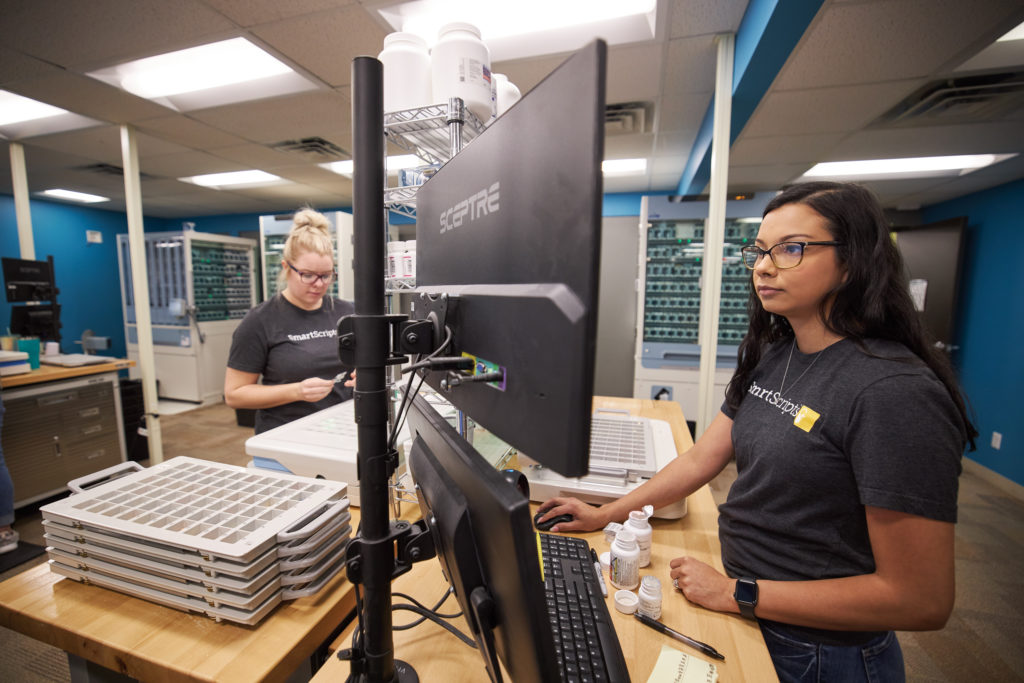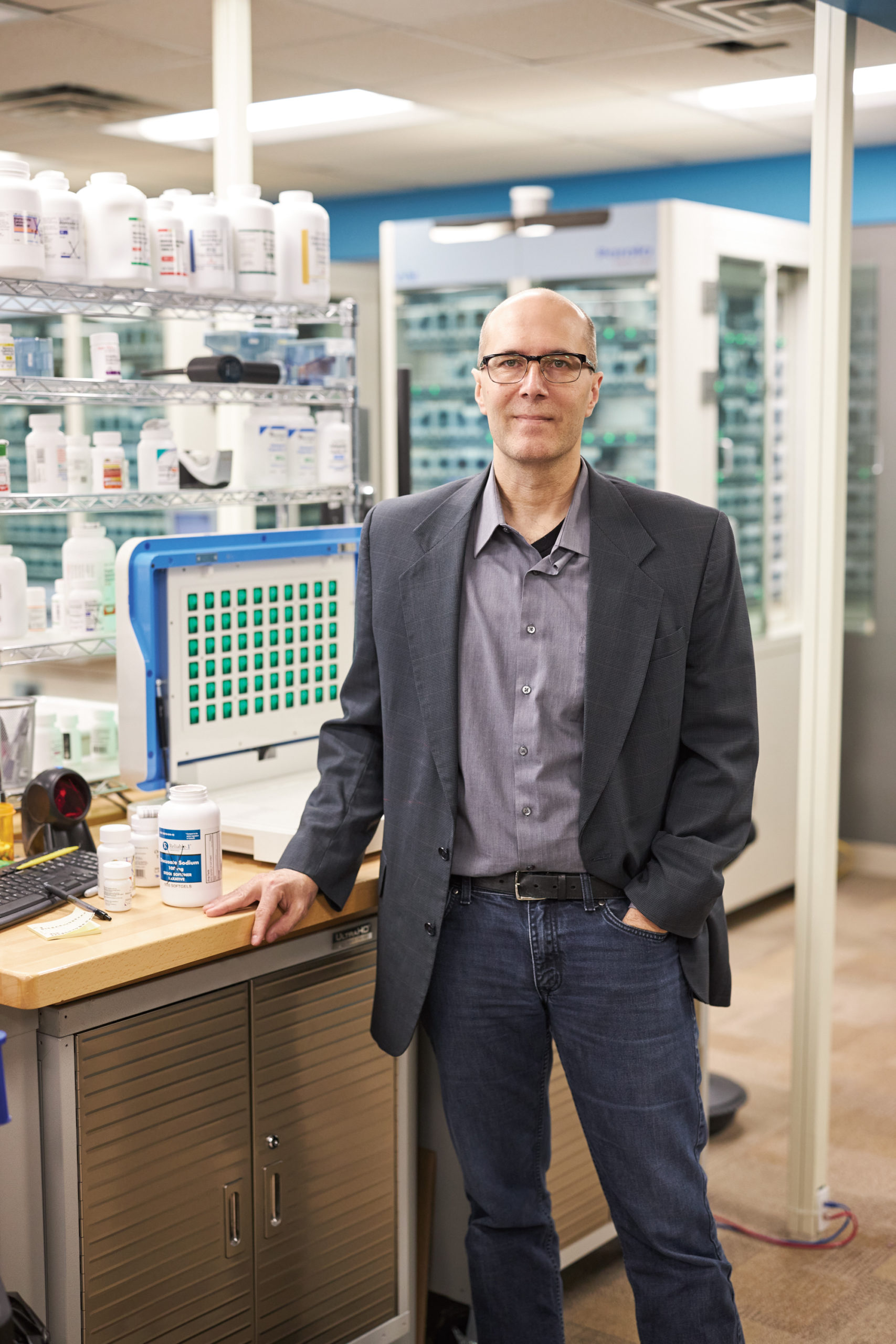SmartScripts, one of the first virtual pharmacies on the market, has an eye toward deeper care services for its patients.
Today, SmartScripts customers receive home delivery of their regular maintenance medications through presorted SmartPacks, which organize multiple medications for patients previously struggling to manage their medication schedules. In 2018, the company introduced a pharmacy benefit manager plan for existing customers who needed assistance lowering the cost of their medications each month — an insurance product that CEO and founder Todd Thompson estimates 90% of SmartScripts’ existing customer base now uses.
In the future, Thompson wants the pharmacy to take on more care coordination roles for its patients — managing refill communications with health care providers’ offices and launching its own telehealth services for providers and patients.
“This is more of a total-care coordination — helping that patient through the entire journey, whether it’s just pharmacy, doctor visits, or lab visits,” he said.
Thompson launched SmartScripts in 2017, after years of owning traditional independent pharmacies and working with patients who struggled to manage multiple daily medications. At the beginning of 2021, SmartScripts employed 120 staff members and served between 8,000 and 10,000 customers nationwide. SmartScripts is based in Iowa City, with locations in Washington, Iowa, and Fort Worth, Texas.
How do you describe SmartScripts?
THOMPSON: We are a direct-to-consumer online pharmacy model. We’re licensed in nearly 50 states, we ship to all 50 states on a regular basis. We typically focus on patients with multiple chronic disease [conditions] because of the way that we package medications in order to try and make that process simpler. … Diabetes, chronic obstructive pulmonary disease, congestive heart failure would be the big diseases we work with. So these are individuals who are balancing multiple medications. The average SmartScripts patient has 8.5 medications.
We’re not [in] direct interaction with patients when it’s vaccines, or if someone needs an antibiotic, something quick — that’s typically not the arena that we operate in. We’re very structured maintenance medications, month after month — those are the kind of patients that we work with.
How did you transition from a traditional pharmacy model to a virtual, delivery model?
One of the things that’s awesome about being based in Iowa is the service that our employees are willing to provide for our patients, so there’s this very down-to-earth ability to speak with anyone, anywhere in the country, whether it’s East Coast individuals, West Coast, the South — our team can really interact with all those people. … That one-to-one interaction took us a little bit to understand, how do we interact with these people virtually — whether through text, email or phone calls?
There [were] some kind of base components that we needed to obtain and really learn how to do that over the last couple of years and get fairly efficient at being able to get that information, and how to interact with them, how to make sure that we were educating the patients properly.
We opened the first tele-pharmacies in the state of Iowa a few years ago with the help of my son, who started a company called TelePharm. So we had a background of interacting with patients digitally, and we still do some of that with a web platform. But we also reach these patients [through] straight telephone communications, text, email, whatever method happens to work easiest for the patient.

How common are virtual pharmacy services right now?
It’s really uncommon. They’re becoming more and more prevalent, but I think there’s less services that offer the types of things we offer today. There’s the Romans, the Hims, the Hers, pharmacies of that nature out there today.
We’re really focused on knowing that the patient’s outcomes change, that we improve their health and lifestyle so it’s not just a monthly quick fix. There aren’t a lot of pharmacies that operate in the space that we do today. There’s three or four major players: Pillpack, which is part of Amazon today. There is another company here in the Midwest called DivvyDose, and then one in Ohio called ExactCare. Those are really the only three that were even somewhat similar to what we do.
What we did a few years ago, we created our own small insurance company called a pharmacy benefit manager, and that allows us to offer discounts to patients that they wouldn’t be able to typically get from regular pharmacies. In the pharmacy world, we’re prohibited from offering discounts to patients on copays and things of that nature because of the insurance company and some of the limitations. When we created our own [insurance product], it gave us the ability to offer individuals who might be struggling with high-cost medications some extra discounts.
What is a pharmacy benefit manager?
What we do is typically when a patient comes into our system … if they have some high-cost medications and they might be struggling with a copay, most of these people would be eligible for our insurance product.
Typically insurance companies have prohibited retail pharmacies like ourselves or mail-order pharmacies from discounting that patient’s copay. If their copay is $50, it’s $50 at Walmart, Walgreens or CVS. However, we’re able to use our insurance product in a secondary position and discount that copay by $5, $10, $15, whatever the regulatory allowances are — discount that and help that patient afford the needed maintenance medication. It’s a very strong competitive advantage over some of those competitors, but also an ability for us to do some things to help patients continue to get medications.
It’s quite well received. I think over 90% of our patient base is able to utilize that today.
How has this last year affected telemedicine?
We didn’t expect patients would be seeking out an option like ours quite as much as they [did]. But because most of our patients are complex, multi-disease-state patients which might be high-risk going into a pharmacy, we had a flood of individuals head towards our model. We doubled between March and June in our total volume, and it was a real challenge for us just to handle the growth, and to be able to manage those patients. It was just a great experience, definitely a challenge, but we continue to grow.
What are the trends you see developing for the next two years or so?
You’re seeing this push towards vertical integration, adding services like we’ve talked about today: adding telemedicine, adding partnerships with lab entities, vertically integrating software platforms so you can talk or speak with [electronic health record] systems.
The market is so enormous, I don’t know that you’ll ever see it saturated from entities like ours until there’s more, larger players in the marketplace. I think you’ll see larger and larger players beginning to enter this telehealth/telepharmacy space.
You have to be cognizant of large entities like Amazon getting into the space, whether or not it’s because they offer improved services or improved platform access. You have to make sure that you provide really high-level service in order to be competitive with entities like that.
What are the “care coordination” services you provide?
We’re beginning to really round out the services and take care of the entire prescription life for a patient, meaning that if a patient is getting low on refills, we’re proactively seeking out refills with the doctor’s office. … That’s taking a step beyond traditional pharmacy.
We have a really robust software platform of our own internally, that we built to do a lot of that. We have a strong technology team that helps us continue to build that and evolve all the time.
We’re constantly building out new tools to be able to manage those patients and keep up with the needs of the patient. It’s a back-office software platform that we built for our team to be more efficient and allow us to scale, but then the next step would be to create something that’s more interactive for the patients that’s front-facing. We’ll continue to add to the technology team so that we can do some of those things.
How do you see your services growing in the next year?
Where we lose the majority of our patients are individuals who aren’t able to stay in the system because they run out of refills. Nearly 70% of our patients come from an economic demographic where they may struggle financially. That might mean they struggle to get to the physician, they may struggle with prescriber copays. What we’re looking at is adding our own internal telemedicine service that we can help service these patients, providing refills on maintenance medications that are needed. One of the things that is most disappointing to me is to see a diabetic patient who may run out of refills, [and] we’re unable to prescribe the drug because they can either not get the [medicine] to the prescriber or they can’t afford a copay at the doctor’s office.
We’re looking at trying to add a telemedicine service for some of those patients that might be at a lower cost. We’re going to partner with some lab services as well, so that we can provide the labs and the telemedicine visits for the patients directly. Most likely, we see this as kind of a gig economy-type opportunity for the prescribers. We will have a medical director on staff, and potentially a few practitioners of our own in-house. A lot of that will be an opportunity for prescribers to be able to pick up some of these appointments on their own through a platform we’re creating. We’ll make it available to our patient population, which at that time will probably be between 12,000 and 15,000 when we roll it out.
I’m really confident in our team. In the past we’ve always been able to kind of rise to the challenge and figure out ways to get through different problems or unique situations that pop up. We really want to continue to offer and develop services for the patients where we handle that prescription life and the patient’s health care side — not just prescriptions, but whether it’s doctor visits, refill appointments, lab appointments — as more of a vertically integrated solution and experience for the patient.
